

When many plants are grown from one plant using man-made methods, it is called artificial propagation. Plantlets growing in the margin of bryophyllum leaf. Vegetative propagation of potato plant from a Potato tuber. Plants that undergo vegetative propagation are green grass, Bryophyllum, money plant, potato plant, onion, banana, etc. The buds which are present in dormant state in old plant are provided with suitable conditions like moisture and warmth so that they grow and develop to form a new plant. In vegetative propagation, parts of old plant like stems, roots and leaves are used to grow a new plant. This form of asexual reproduction occurs in plants only. Spirogyra, a filament type algae plant reproduces by the method of fragmentation. Spirogyra which is a plant and sea anemones which is a sea animal undergoes the process of fragmentation. Each piece than grows into a new organism. In this process the multicellular organism breaks into two or more pieces on maturation. Once it gets mature, it detaches from the parent body.Fragmentation occurs in multicellular organisms, be it plants or animals. From the parent hydra, a bud arises which eventually matures into a new hydra. These buds develop into a new individual. Some organisms develop buds on their body. In these organisms, when the cell divides into numerous pieces, each piece proliferates and differentiates to regenerate new organisms. Organisms like hydra and planaria also show regeneration. In many organisms, there are specialized cells, which can differentiate and grow into a new organism. When a lizard loses its tail, it grows a new one. Later, each fragment develops into a new individual. The parent body divides into two or more fragments. Multi-cellular organisms like planaria, spirogyra, etc. 2) Fragmentationįragmentation is another mode of asexual reproduction. Examples of multiple fission are sporozoans and algae. Organisms like the amoeba, bacteria, euglena, etc., exhibit binary fission.ĭuring multiple fission, organism divides itself into numerous daughter cells. Daughter cells are identical to each other and to their parent cell. In binary fission, parent cell divides into two equal halves called daughter cells.

For example, an amoeba can divide itself into two at any plane but the division in euglena is longitudinal.įission can be of two types, namely, binary fission and multiple fission. Unicellular organisms show different patterns of cell division according to their cell structure. During asexual reproduction, the parent cell divides into two or more cells. Let us now look at the different modes of asexual reproduction in brief. Some of the asexual methods are binary fission (e.g. Organisms choose to reproduce asexually by different means. There is limited variation (genetically similar offsprings).Rapid multiplication and growth happens.The whole process takes place in a small period of time.There is no gamete formation or fertilization.We observe asexual reproduction in both unicellular and multicellular organisms.

They are the exact copies of their parent cell. The offsprings are identical to each other, both physically as well as genetically. Asexual reproduction is a mode of reproduction in which the new offspring arise from a single parent.


 0 kommentar(er)
0 kommentar(er)
